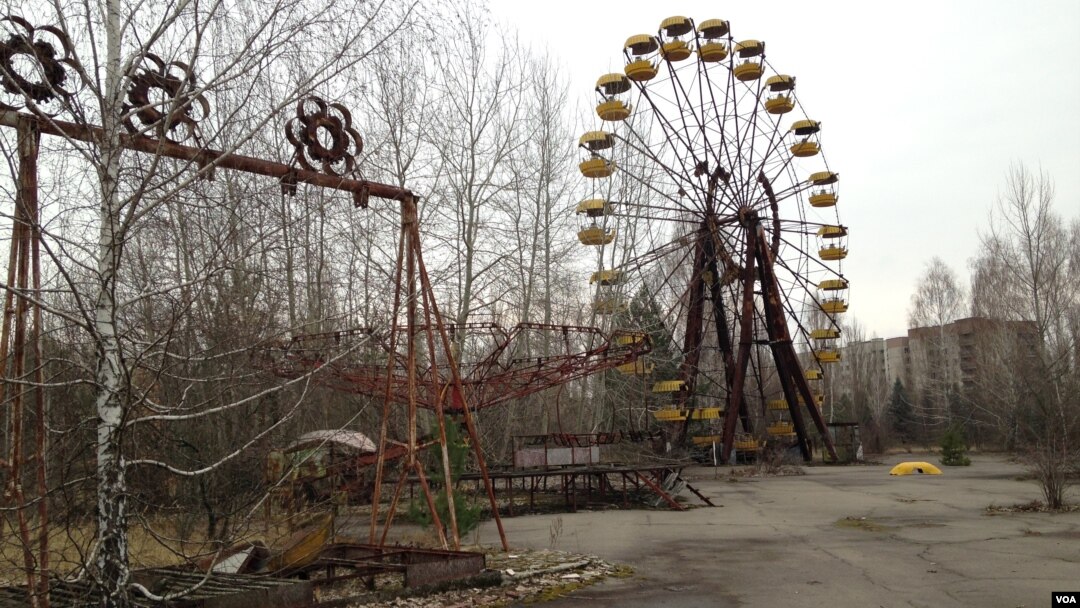In the early hours of April 26, 1986, Reactor 4 at the Chernobyl nuclear power plant in then Soviet-controlled Ukraine exploded, releasing huge amounts of radiation into the air.
One-hundred-sixteen-thousand people living around the plant were evacuated, and 220,000 more were forced to leave in subsequent years as the so-called contaminated ‘death zone’ was expanded. For the evacuees, the pain is still felt three decades later.
Alexandr Gruzevitch, 58, said he rarely returns to his childhood home because the pain is too great to bear. He lived with his parents at number 6 Leningradskaya in Chernobyl town. Climbing through the brambles and bushes that have overtaken the garden, he showed VOA inside.
“When I was a little boy, my mother made a large fire in the hearth. In the winter, when it was frosty, the hearth was well warmed,” he said, the tears welling in his eyes.
Parts of the ceiling have caved in and the floorboards are rotting. Gruzevitch thinks it will probably collapse in a couple of years.
Before dawn on April 26, 1986, Gruzevitch, then a 28-year-old working as a foreman in a local agricultural school, went outside to smoke a cigarette.
“I saw something like a glow, something like a sunset,” he said. “It had such a blood-red color. I thought to myself 'What a very strange time for such a glow. What sun could be here at this time?' The next day, however, we weren’t told a thing.”

FILE - A Ferris wheel is seen in the Pripyat amusement park in what has become an iconic symbol of the Chernobyl nuclear distaster. (A. Arabasabi/VOA)
Sixteen kilometers away, the scale of the disaster unfolding at the nuclear power station was becoming clear. The order to evacuate Chernobyl came 10 days later and Gruzevitch and his family, along with tens of thousands of others, were forced to leave. Soviet authorities told them they would be able to return a few weeks later, a lie aimed at preventing panic. By then it was clear that a huge area had been exposed to lethal radiation.
Ghost town
Directly downwind, the town of Pripyat housed the workers from the power station. Many watched the fire take hold from the balconies of their apartments. The town is now a disturbing monument to the world’s worst nuclear accident. As the buildings slowly crumble, radioactive birch trees are reclaiming the land.
In the local school, child-sized gas masks, precautions amid the paranoia of the Cold War, litter a classroom floor, while discarded text books praise the achievements of the Soviet Union. Amid the desolation, there are startling signs of life.
A few hundred mostly elderly evacuees have resettled in the exclusion zone and are quietly tolerated by authorities. Many cultivate their own food despite warnings that contamination rises rapidly just below the surface.
FILE - An abandoned apartment building is seen in the once bustling town of Pripyat. The 1986 explosion at the nearby Chernobyl nuclear power plant uprooted more than 300,000 people. (D. Markosian/VOA)
Chernobyl town still houses around 3,000 people who continue to work on decommissioning the plant. They can only stay inside the zone for 14 days at a time.
Once a week, Alexandr Gruzevitch travels from Kyiv to work in a hospital in Chernobyl, just a few minutes walk from his old home.
“My mother used to say to my father 'Let’s come back, let’s come back.' But they did not manage to do it. However, about a month after the accident, my father and I came to our old house. It was destroyed. The windows were broken, the doors were open. All our things were stolen. Nothing was left.”
Scientists say the exclusion zone won’t be safe to live in for another 20,000 years. But for some evacuees, Chernobyl remains home and the urge to return outweighs the invisible dangers that lurk all around.

